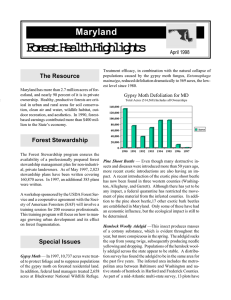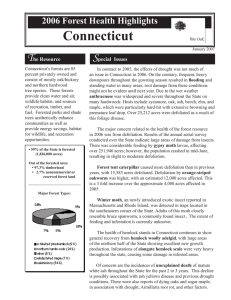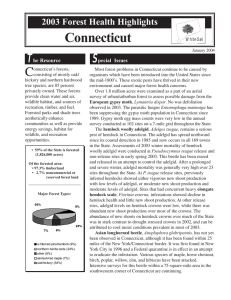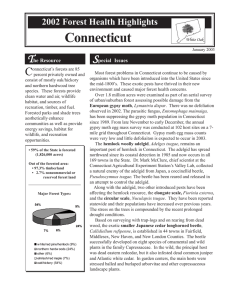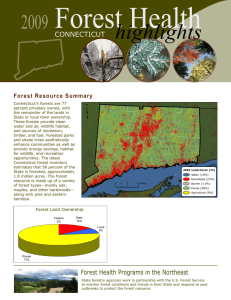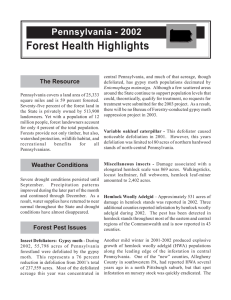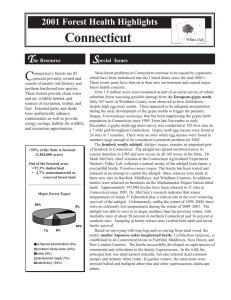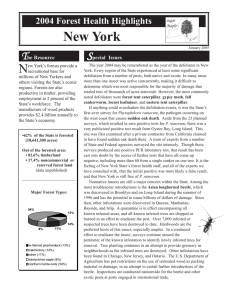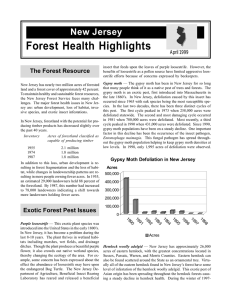Connecticut T S 2005 Forest Health Highlights
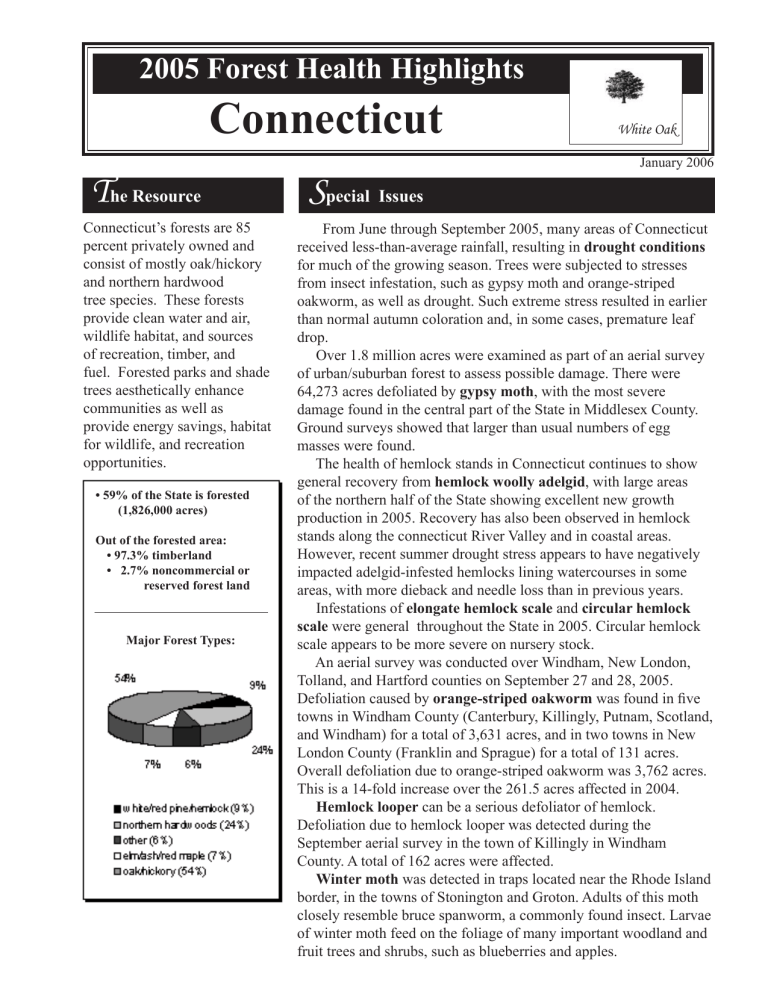
2005 Forest Health Highlights
Connecticut
T
he Resource
Connecticut’s forests are 85 percent privately owned and consist of mostly oak/hickory and northern hardwood tree species. These forests provide clean water and air, wildlife habitat, and sources of recreation, timber, and fuel. Forested parks and shade trees aesthetically enhance communities as well as provide energy savings, habitat for wildlife, and recreation opportunities.
• 59% of the State is forested
(1,826,000 acres)
Out of the forested area:
• 97.3% timberland
• 2.7% noncommercial or
reserved forest land
Major Forest Types:
White Oak
January 2006
S
pecial Issues
From June through September 2005, many areas of Connecticut received less-than-average rainfall, resulting in drought conditions for much of the growing season. Trees were subjected to stresses from insect infestation, such as gypsy moth and orange-striped oakworm, as well as drought. Such extreme stress resulted in earlier than normal autumn coloration and, in some cases, premature leaf drop.
Over 1.8 million acres were examined as part of an aerial survey of urban/suburban forest to assess possible damage. There were
64,273 acres defoliated by gypsy moth , with the most severe damage found in the central part of the State in Middlesex County.
Ground surveys showed that larger than usual numbers of egg masses were found.
The health of hemlock stands in Connecticut continues to show general recovery from hemlock woolly adelgid , with large areas of the northern half of the State showing excellent new growth production in 2005. Recovery has also been observed in hemlock stands along the connecticut River Valley and in coastal areas.
However, recent summer drought stress appears to have negatively impacted adelgid-infested hemlocks lining watercourses in some areas, with more dieback and needle loss than in previous years.
Infestations of elongate hemlock scale and circular hemlock scale were general throughout the State in 2005. Circular hemlock scale appears to be more severe on nursery stock.
An aerial survey was conducted over Windham, New London,
Tolland, and Hartford counties on September 27 and 28, 2005.
Defoliation caused by orange-striped oakworm was found in five towns in Windham County (Canterbury, Killingly, Putnam, Scotland, and Windham) for a total of 3,631 acres, and in two towns in New
London County (Franklin and Sprague) for a total of 131 acres.
Overall defoliation due to orange-striped oakworm was 3,762 acres.
This is a 14-fold increase over the 261.5 acres affected in 2004.
Hemlock looper can be a serious defoliator of hemlock.
Defoliation due to hemlock looper was detected during the
September aerial survey in the town of Killingly in Windham
County. A total of 162 acres were affected.
Winter moth was detected in traps located near the Rhode Island border, in the towns of Stonington and Groton. Adults of this moth closely resemble bruce spanworm, a commonly found insect. Larvae of winter moth feed on the foliage of many important woodland and fruit trees and shrubs, such as blueberries and apples.
S
pecial Issues cont.
Balsam woolly adelgid has been seen on an occasional landscape fir. The few indigenous populations to not seem to threaten nearby managed Fraser fir Christmas trees.
White pine weevil has become a perennial pest, with moderate damage occurring almost every year.
Surveys for other exotic pests:
Surveys near commercial nurseries and in isolated woodlands have not detected
Phytophthora ramorum , the causal agent of Ramorum blight , formerly known as sudden oak death.
Asian longhorned beetle has not been reported or found in surveys, much to our great relief and good fortune. In 2005,
122 trees were examined in southwestern Connecticut for signs of infestation. In addition to the intensive surveys, conducted within a 75-square mile area in the southwestern part of the State, we are now inspecting neglected areas adjoining industrial parks that receive material and supplies packed in pallets, as the beetle may gain entry by that route.
White spotted sawyer and conifer seed beetle are most frequently confused with the
Asian longhorned beetle.
Pine shoot beetle and emerald ash borer have not been found in the State.
R
egional Surveys
National Forest Health
Monitoring Program
In cooperation with the USDA
Forest Service, Connecticut participates in the National
Forest Health Monitoring
Program. The program’s objective is to assess trends in tree condition and forest stressors. All of the New
England States have been involved since the program was initiated in 1990. A healthy forest is defined as having the capacity for renewal, for recovery from a wide range of disturbances, and for retention of its ecological resiliency.
The overall health of the forests in New England is good, with various damage agents present at different times and locations. Results from permanent sample sites indicate that there has been minimal change in crown condition in recent years. There are varying impacts from forest fragmentation, drought, fire, insects, and pathogens. The most significant pests are those that have arrived from other parts of the world, such as the gypsy moth, beech bark disease, and hemlock woolly adelgid. A
Forest Health
Monitoring
Sites
In addition to the Forest
Health Monitoring Program, a network of 51 permanent forest sites have been established to monitor forest health on various
State, Nature Conservancy, and municipal water company properties. The sites are visited annually to assess whether State forests remain healthy or are declining. Trees are evaluated for signs of defoliation and disease. These plots will continue to be used to assess
F or More Information
CT Agric. Experimental Station
P.O. Box 1106
123 Huntington Street
New Haven, CT 06504-1106
(203) 974-8474
Forest Health Protection
USDA Forest Service
P.O. Box 640
Durham, NH 03824
(603) 868-7709
State and Private
Forestry

